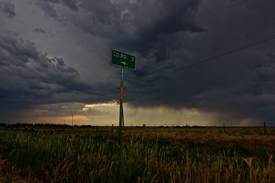‘Severe Weather Field Trip’ took budding meteorologists to Tornado Alley
A few days in to their adventure, students who signed up for the new 3-credit course “Severe Weather Field Trip” spotted the Holy Grail for storm chasers. Just north of Cheyenne, Wyoming, 15 Rutgers students watched a swirling tornado.
The sighting was a highlight of the two-week storm-chasing caravan that crisscrossed the highways and back roads of Tornado Alley.
“From a safe distance of 10 miles, we saw [the tornado] quite clearly, not as a big funnel but as swirling dust,” said Steven Decker, an assistant professor in the School of Environmental and Biological Sciences. “Even if we hadn’t seen a tornado, every team of students managed to see severe thunderstorms, their structure. It was exciting, dramatic and fun to see.”
The new summer course was designed to help students “better understand the dynamics and thermodynamics that lead to some of the most beautiful yet complex atmospheric circulations on Earth,” according to its course description.
Decker had advised his students, who recently returned from the trip, that, “Putting ourselves near severe weather is a dangerous activity.”
But he reminded his charges (including one student from Kean University) that driving 7,000 miles across country was inherently more dangerous than watching a distant storm. Nonetheless, he told the group they would keep a minimum respectful distance of five miles, preferably to the southeast of the activity, which would be precipitation and lightning free and allow two escape routes if the need arose.
“Indeed, spectacular success can be had and tornadoes can be seen without ever needing to turn on the windshield wipers,” according to Decker.

These future meteorologists were more than ready for the experience. Despite their relative youth, many have been weather fans for years.
“I was just a little kid,” said 22-year-old Anthony Adams, “but I remember going to the shore and seeing a hurricane. I was hooked. I’d eventually like to do field work on storm watches and awareness. I want to increase public understanding about severe weather and improve methods of communication to reach people [about storms] in time.”
Rebecca Evrard, 20, of Ewing, grew up closely monitoring the weather with her father who was a commercial pilot. “We talked about weather all the time,” the junior said, “and I was always watching storms from behind our glass doors.”
Evrard is not sure where her future lies. “Maybe broadcast, maybe research in meteorology. I don’t know yet,” she admitted. But like her traveling companions, Evrard will be well prepared for a career in meteorology if all their professors are like Decker, whose planning for this initial field trip was meticulous.
At a three-hour-plus orientation, students were given thick packets of reading material, all manner of charts and weather resources plus daily assignments, from choosing the next day’s chase route to monitoring weather radios, checking real-time data on laptops, taking photos and logging and blogging. Many items on the checklist were pertinent for all kinds of travelers, not just would-be storm chasers: tips on proper packing for an extended road trip, getting along in cramped conditions and how to make K-turns on narrow, muddy roads without getting stuck in a ditch.
“Our first day as the forecasters, we were in the Texas-Oklahoma panhandle and it was a bust,” Evrard said. “We were trying to chase a storm but it fell apart. A few days later, we were forecasting again and we located a super cell near Pine Bluffs, Wyoming [on the border with Nebraska]. It didn’t drop a tornado but it was trying. It had a wall cloud – that’s where the funnel comes from – but it wasn’t strong enough.
“But it was a nice warm-up for the following day when we got the tornado.”
While Decker, too, was hoping to view a twister, his goal for the students was to “have them learn about thunderstorms by predicting them, observing them in the field and then analyzing them scientifically.”